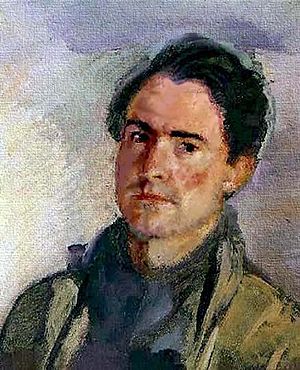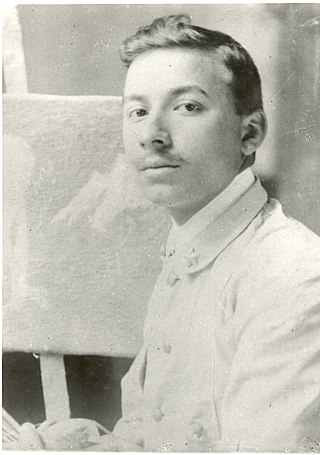
Armando Spadini (1883 - 1925) was an Italian painter and one of the representatives of the so-called Scuola Romana.

Armando Spadini (1883 - 1925) was an Italian painter and one of the representatives of the so-called Scuola Romana.
Armando Spadini, the son of a craftsman and a seamstress from Poggio a Caiano, was born in Florence on 29 July 1883.
After attending the decorated school of Santa Croce he enrolled in the Free School of Nude at the Academy of Fine Arts in Florence where he met Ardengo Soffici and Adolfo De Carolis. In 1901, together with artists such as De Carolis, Galileo Chini, Duilio Cambellotti, Alberto Zardo and many others, he participated in the Alinari competition, obtaining the second prize for the illustration of the Divine Comedy. Soon after he began to make himself known in artistic and literary circles, collaborating with woodcuts and drawings at Papini's "Leonardo" and Borghese's "Hermes".
After completing his military service in 1903-05, he returned to Florence and competed for the 1909 Pensionato artistico nazionale, and was the winner. In 1908 he married Pasqualina Cervone, who he met at the school of Giovanni Fattori, also a painter, who later became the artist's main muse. He moved with her to Rome in 1910, a city in which he initially lived with distrust, but which he soon managed to appreciate.
In Rome he was very close to the critic Emilio Cecchi, who considered him one of the most talented painters of the new century. Armando Spadini was not attracted to the avant-garde and metaphysics, but on the contrary fit into the context of twentieth-century Impressionism.
After a first exhibition at the Pensionato artistico (1912) he participated in the exhibitions of the Secessione Romana in 1913 and 1915, obtaining the first successes. Recalled to the army, he was reformed in 1917 due to the onset of the first symptoms of chronic nephritis which would cause his premature death. He moved with his wife and children to a small villa in Parioli, at the time on the edge of the Roman countryside, which would become the destination of frequent visits from his literary and artistic friends: Emilio Cecchi, Antonio Baldini, Vincenzo Cardarelli, Giovanni Papini, Ardengo Soffici, Giuseppe Ungaretti, Cipriano Efisio Oppo, Giorgio De Chirico and Amerigo Bartoli. He took part in a few exhibitions between Rome and Florence, and in 1918 his works were displayed at the Italian Art exhibition in Zurich, as well as a solo show dedicated to him at the Casina Valadier.
His friendship with Cecchi and Baldini, his frequentation of the cultural environment of the "third room" in the Caffè Aragno helped to bring him closer, in 1919, to the literary magazine "La Ronda".
In 1920, thanks to the interest of Ojetti, who dedicated a short monograph to him that year, he won a professorship in Florence, but renounced it in order stay in Rome.
The growing interest in his painting relieved him of economic difficulties, while his health conditions began to deteriorate. In 1920 he was appointed Academician of S. Luca and from the following year he was part of the committee for the Roman Biennials (1921-1925). In 1922, presented by Savinio, he exhibited his paintings at the spring Fiorentina with the group of "Valori Plastici". In 1923 he took part in the exhibition of Italian art in Buenos Aires. In 1924 he had a personal room, with thirty-seven works, at the XIV Venice Biennale, which consecrated him amongst the now established artists, and was present at the "Carnegie Exhibition" in Pittsburgh. He collaborated with the Soffici magazine "Galleria"; Oppo, Baldini, Cecchi and Soffici dedicated a monograph to him.
Armando Spadini died in Rome on March 31, 1925. His remains rest in the cemetery of Poggio a Caiano, in front of his friend Ardengo Soffici, and on his tombstone it is written: «For art he lived, died, will live».
The 1931 National Quadrennial of Art in Rome dedicated an entire room to the artist with a large collection of his paintings, made available by his collectors.
In his hometown, a street was dedicated to him and one of the 229 busts of illustrious Italians that adorn the Pincio promenade in Rome is dedicated to him.

Giovanni Papini was an Italian journalist, essayist, novelist, short story writer, poet, literary critic, and philosopher. A controversial literary figure of the early and mid-twentieth century, he was the earliest and most enthusiastic representative and promoter of Italian pragmatism. Papini was admired for his writing style and engaged in heated polemics. Involved with avant-garde movements such as futurism and post-decadentism, he moved from one political and philosophical position to another, always dissatisfied and uneasy: he converted from anti-clericalism and atheism to Catholicism, and went from convinced interventionism – before 1915 – to an aversion to war. In the 1930s, after moving from individualism to conservatism, he finally became a fascist, while maintaining an aversion to Nazism.

Ardengo Soffici was an Italian writer, painter, poet, sculptor and intellectual.

Giuseppe Prezzolini was an Italian literary critic, journalist, editor and writer. He later became an American citizen.
Quinto Martini (1908–1990) was an Italian artist and writer, born in Seano, Tuscany.
Cipriano Efisio Òppo was an Italian painter, stage designer, satirical illustrator, and critic. He was born in Rome, the city in which he also lived, worked and died, though his father's and mother's families had both come originally from Sardinia. He was an influential and perceptive commentator and mentor in respect of the Italian art scene through the challenges of the Mussolini years.
Antonio Bueno was an Italian painter of Spanish origin, who acquired Italian citizenship in 1970. He was born in Berlin while his journalist father was posted there by the newspaper ABC of Madrid.

Scuola romana or Scuola di via Cavour was a 20th-century art movement defined by a group of painters within Expressionism and active in Rome between 1928 and 1945, and with a second phase in the mid-1950s.
Alberto Ziveri (1908–1990) was an Italian painter belonging to the modern movement of the Scuola Romana. He is known for his urban landscapes and realist narrative scenes. His use of chiaroscuro in paintings such as Postribolo (1945) recalls the Settecento style.
Guglielmo Janni (1892–1958) was an Italian painter belonging to the modern movement of the Scuola romana .
Emanuele Cavalli (1904–1981) was an Italian painter belonging to the modern movement of the Scuola Romana. He was also a renowned photographer, who experimented with new techniques since the 1930s.

Fausto Calogero Pirandello was an Italian painter belonging to the modern movement of the Scuola romana . He was the son of Nobel laureate Luigi Pirandello.

Enrico Coleman was an Italian painter of British nationality. He was the son of the English painter Charles Coleman and brother of the less well-known Italian painter Francesco Coleman. He painted, in oils and in watercolours, the landscapes of the Campagna Romana and the Agro Pontino; he was a collector, grower and painter of orchids. Because of his supposedly Oriental air, he was known to his friends as "Il Birmano", the Burmese.
Roberto Melli (1885–1958) was an Italian painter and sculptor to the Scuola Romana, and active in Ferrara and Rome.

Giuseppe Capogrossi was an Italian painter.

Adriana Pincherle was an Italian painter.

Virgilio Guidi was an Italian artist and writer.
Leonetta Cecchi Pieraccini was an Italian painter, originally from Tuscany. Like many artists of the period, she is known principally for portraiture, employing watercolours or oils. Her actual output was more diverse, however. She produced a number of landscapes and monotypes. She was also a diligent diarist, and during the later part of her life published several books, which were autobiographical in character. Her work resonated with art lovers and commentators during the first and middle parts of the twentieth century, through which she lived, surviving to a good age. By the time she died, to the regret of admirers, her work was beginning to fall out of favour, however.

Giuseppe Graziosi was an Italian sculptor, painter and graphic designer.

Antonio Baldini was an Italian journalist, literary critic and writer.

Domenico Giuliotti was an Italian writer and essayist. He was a dedicated Catholic and his rigidity and severity are reflected in his numerous works.
![]() Media related to Armando Spadini at Wikimedia Commons
Media related to Armando Spadini at Wikimedia Commons